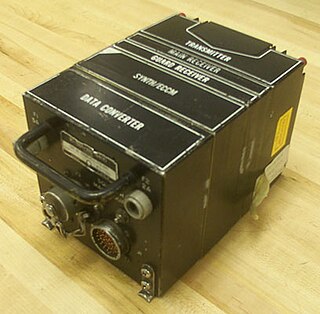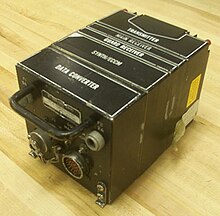
The Northrop Grumman E-8 Joint Surveillance Target Attack Radar System is a United States Air Force airborne ground surveillance, battle management and command and control aircraft. It tracks ground vehicles and some aircraft, collects imagery, and relays tactical pictures to ground and air theater commanders. The aircraft is operated by both active duty U.S. Air Force and Air National Guard units and also carries specially trained U.S. Army personnel as additional flight crew.

Very high frequency (VHF) is the ITU designation for the range of radio frequency electromagnetic waves from 30 to 300 megahertz (MHz), with corresponding wavelengths of ten meters to one meter. Frequencies immediately below VHF are denoted high frequency (HF), and the next higher frequencies are known as ultra high frequency (UHF).

Citizens band radio, used in many countries, is a land mobile radio system, a system allowing short-distance person-to-many persons bidirectional voice communication among individuals, using two way radios operating on 40 channels near 27 MHz (11 m) in the high frequency band. Citizens band is distinct from other personal radio service allocations such as FRS, GMRS, MURS, UHF CB and the Amateur Radio Service. In many countries, CB operation does not require a license, and it may be used for business or personal communications. Like many other land mobile radio services, multiple radios in a local area share a single frequency channel, but only one can transmit at a time. The radio is normally in receive mode to receive transmissions of other radios on the channel; when users want to talk they press a "push to talk" button on their radio, which turns on their transmitter. Users on a channel must take turns talking. Transmitter power is limited to 4 watts in the US and the EU. CB radios have a range of about 3 miles (4.8 km) to 20 miles (32 km) depending on terrain, for line of sight communication; however, various radio propagation conditions may intermittently allow communication over much greater distances.

Ultra high frequency (UHF) is the ITU designation for radio frequencies in the range between 300 megahertz (MHz) and 3 gigahertz (GHz), also known as the decimetre band as the wavelengths range from one meter to one tenth of a meter. Radio waves with frequencies above the UHF band fall into the super-high frequency (SHF) or microwave frequency range. Lower frequency signals fall into the VHF or lower bands. UHF radio waves propagate mainly by line of sight; they are blocked by hills and large buildings although the transmission through building walls is strong enough for indoor reception. They are used for television broadcasting, cell phones, satellite communication including GPS, personal radio services including Wi-Fi and Bluetooth, walkie-talkies, cordless phones, satellite phones, and numerous other applications.
The L band is the Institute of Electrical and Electronics Engineers (IEEE) designation for the range of frequencies in the radio spectrum from 1 to 2 gigahertz (GHz). This is at the top end of the ultrahigh frequency (UHF) band, at the lower end of the microwave range.
Code of Federal Regulations, Title 47, Part 15 is an oft-quoted part of Federal Communications Commission (FCC) rules and regulations regarding unlicensed transmissions. It is a part of Title 47 of the Code of Federal Regulations (CFR), and regulates everything from spurious emissions to unlicensed low-power broadcasting. Nearly every electronics device sold inside the United States radiates unintentional emissions, and must be reviewed to comply with Part 15 before it can be advertised or sold in the US market.

A two-way radio is a radio that can both transmit and receive radio waves, unlike a broadcast receiver which only receives content. It is an audio (sound) transceiver, a transmitter and receiver in one unit, used for bidirectional person-to-person voice communication with other users with similar radios. Two-way radios are available in stationary, mobile, and hand-held portable models. Hand-held two-way radios are often called walkie-talkies, handie-talkies or hand-helds. Two-way radios are used by groups of geographically separated people who need to keep in continuous voice communication, such as aircraft pilots and air traffic controllers, ship captains and harbormasters, emergency services personnel like firefighters, police officers, and ambulance paramedics, taxi and delivery services, soldiers and military units, fast food and warehouse employees, and radio amateurs.

The Joint Tactical Radio System (JTRS) aimed to replace existing radios in the American military with a single set of software-defined radios that could have new frequencies and modes (“waveforms”) added via upload, instead of requiring multiple radio types in ground vehicles, and using circuit board swaps in order to upgrade. JTRS has seen cost overruns and full program restructurings, along with cancellation of some parts of the program. JTRS is widely seen as one of the DoD's greatest acquisition failures, having spent $6B over 15 years without delivering a radio.

HAVE QUICK is an ECM resistant / frequency-hopping system used to protect military aeronautical mobile (OR) radio traffic.
Airband or aircraft band is the name for a group of frequencies in the VHF radio spectrum allocated to radio communication in civil aviation, sometimes also referred to as VHF, or phonetically as "Victor". Different sections of the band are used for radionavigational aids and air traffic control.
Shortwave bands are frequency allocations for use within the shortwave radio spectrum. Radio waves in these frequency ranges can be used for very long distance (transcontinental) communication because they can reflect off layers of charged particles in the ionosphere and return to Earth beyond the horizon, a mechanism called skywave or “skip” propagation. They are allocated by the ITU for radio services such as maritime communications, international shortwave broadcasting and worldwide amateur radio. The bands are conventionally named by their wavelength in metres, for example the ‘20 meter band’. Radio propagation and possible communication distances vary depending on the time of day, the season and the level of solar activity.

A television antenna is an antenna specifically designed for use with a television receiver (TV) to receive over-the-air broadcast television signals from a television station. Television reception is dependent upon the antenna as well as the transmitter. Terrestrial television is broadcast on frequencies from about 47 to 250 MHz in the very high frequency (VHF) band, and 470 to 960 MHz in the ultra high frequency (UHF) band in different countries. Television antennas are manufactured in two different types: "indoor" antennas, to be located on top of or next to the television set, and "outdoor" antennas, mounted on a mast on top of the owner's house. They can also be mounted in a loft or attic, where the dry conditions and increased elevation are advantageous for reception and antenna longevity. Outdoor antennas are more expensive and difficult to install, but are necessary for adequate reception in fringe areas far from television stations. The most common types of indoor antennas are the dipole and loop antennas, and for outdoor antennas the Yagi, log periodic, and for UHF channels the multi-bay reflective array antenna.

The AN/ARC-5 Command Radio Set is a series of radio receivers, transmitters, and accessories carried aboard U.S. Navy aircraft during World War II and for some years afterward. It is described as "a complete multi-channel radio transmitting and receiving set providing communication and navigation facilities for aircraft. The LF-MF-HF components are designed to transmit and receive voice, tone-modulated, and continuous wave (cw) signals." Its flexible design provided AM radiotelephone voice communication and Modulated continuous wave (MCW) and Continuous wave (CW) Morse code modes, all of which are typical capabilities in other Navy aircraft communication sets of the period. It was an improvement of the Navy's ARA/ATA command set. Similar units designated SCR-274-N were used in U.S. Army aircraft. The Army set is based on the ARA/ATA, not the later AN/ARC-5. The ARA/ATA and SCR-274-N series are informally referred to as "ARC-5", despite small differences that render all three series incompatible. Like the AN/ARC-5, the ARA/ATA and SCR-274-N had AM voice communication and two-way MCW and CW Morse code capability.

The AN/ARC-190 is an airborne HF communications system, found on C-130, C-20, KC-135, C-141, C-5, C-9, KC-10, B-1, B-52, C-17, E-3, E-4, E-8 JSTARS, F-15, F-16, H-53, H-60, S-2T, and Bell Boeing V-22 Osprey aircraft.

The AN/PRC-117 is a man-portable, tactical software-defined combat-net radio, manufactured by Harris Corporation, in two different versions:

Radio is the technology of signaling and communicating using radio waves. Radio waves are electromagnetic waves of frequency between 30 hertz (Hz) and 300 gigahertz (GHz). They are generated by an electronic device called a transmitter connected to an antenna which radiates the waves, and received by another antenna connected to a radio receiver. Radio is very widely used in modern technology, in radio communication, radar, radio navigation, remote control, remote sensing, and other applications.
The AN/ARC-34 is a UHF aircraft radio transceiver that was used in many U.S. aircraft of the 1950s and 1960s, such as the A-37, B-52, B-57, F-5, F-86, F-100, F-101, F-102, C-130, C-135, C-137, C-140, CH-3, H-43, H-53, T-38, T-39 and U-2.

The ARC-210 is a family of radios for military aircraft that provides two-way, multi-mode voice and data communications over a 30 to 512+ MHz frequency range. It covers both Ultra High Frequency (UHF) and Very High Frequency (VHF) bands with AM, FM and SATCOM capabilities. The ARC-210 radio also includes embedded anti-jam waveforms, including Havequick and SINCGARS, and other data link and secure communications features, providing total battlefield interoperability and high-performance capabilities in the transfer of data, voice and imagery. It features a separate guard receiver for monitoring 121.5 and 243 MHz while simultaneously monitoring the active channel selected. Transmitter power ranges from 5 to 23 watts, depending on frequency and mode. The radios communicates with other avionics over a MIL-STD-1553 data bus.
The ARC-231 Skyfire is a software-definable radio for military aircraft that provides two-way, multi-mode voice and data communications over a 30 to 512 MHz frequency range. It covers both line-of-sight Ultra High Frequency (UHF) and Very High Frequency (VHF) bands with AM, FM and SATCOM capabilities, including Integrated Waveform (IW). The ARC-231 radio also includes embedded anti-jam waveforms, including HAVE QUICK and SINCGARS, and other data link and secure communications features, providing battlefield interoperability. The radios utilize the MIL-STD-1553 data bus.
The AN/ARC-182 is a family of military aircraft radio transceivers designed for two-way, multi-mode voice communications over a 30 to 400 MHz frequency range. It covers both Ultra High Frequency (UHF) and Very High Frequency (VHF) bands with AM, FM, as appropriate. The ARC-182 radio supports the HAVE QUICK II anti-jam waveforms, with an optional control unit. It features a guard channel capability for monitoring 40.5, 121.5, 156.8 and 243 MHz. Transmitter minimum power is 10 watts, AM, and 15 watts, FM. The RT-1250A model radio can communicate with other avionics over a MIL-STD-1553 data bus.














